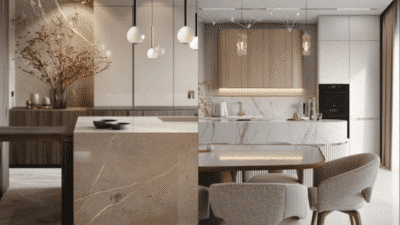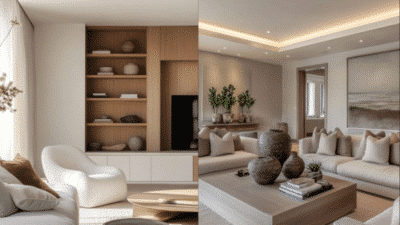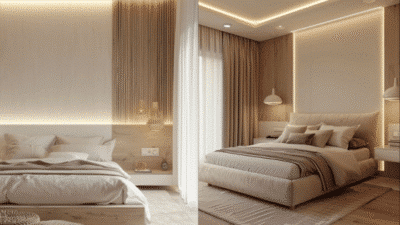Your entryway serves as the first impression of your home, showcasing your interior style and family personality to every visitor who steps through your door. More than just a transitional space, it sets the tone for the rest of your home while providing practical functionality for daily comings and goings. A well-designed entryway balances aesthetic appeal with storage solutions that keep clutter at bay while reflecting your unique design sensibilities.
In 2025, entryway design continues to evolve with a focus on making big impressions in small spaces. Whether you have a grand foyer with room for statement furniture or a modest hallway that requires creative space-saving solutions, there are countless ways to transform this area. The key is understanding how to layer elements like lighting, furniture, wall treatments, and decorative accents to create a cohesive look that welcomes both you and your guests.
Key Takeaways
- Your entryway creates the first impression of your home and should balance visual appeal with practical functionality.
- Thoughtful lighting, strategic furniture placement, and personal touches transform even small entryways into impactful spaces.
- Regular organization and maintenance of your entryway ensures it remains both beautiful and functional throughout changing seasons.
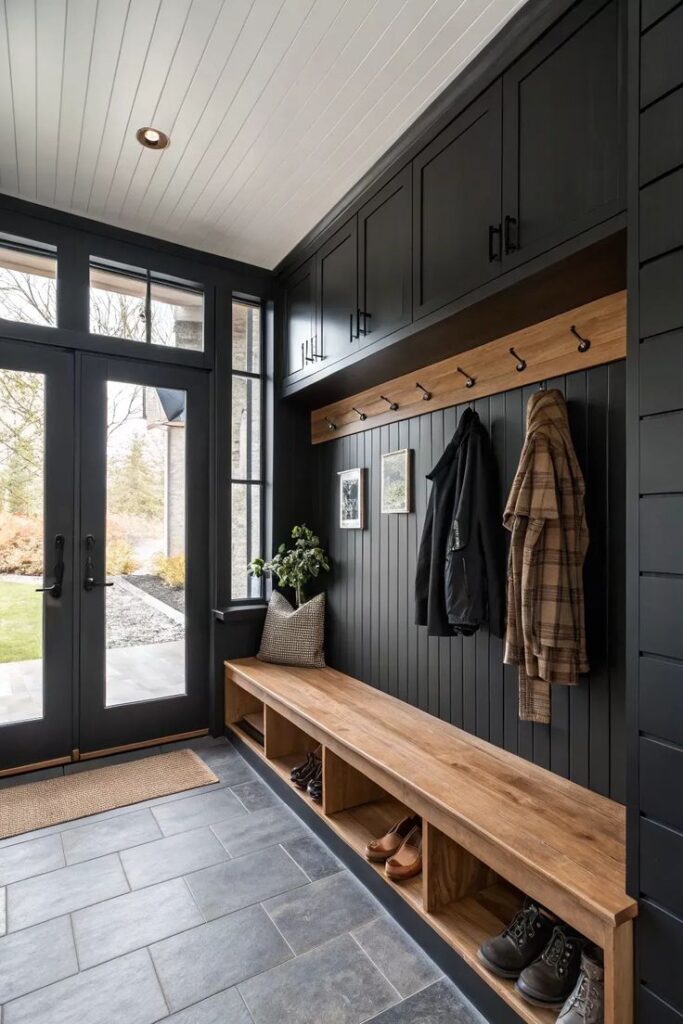
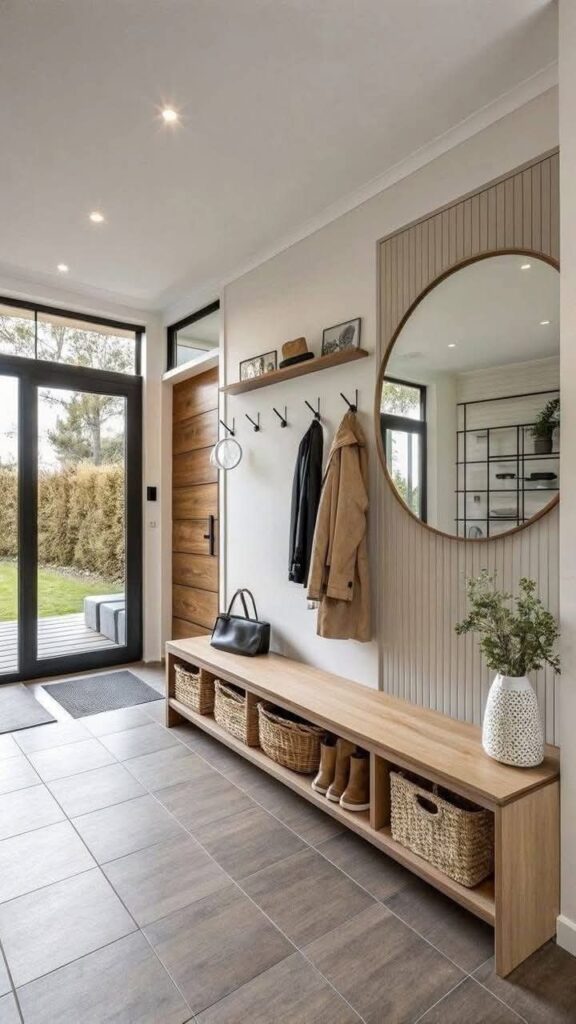
Fundamentals of Entryway Interior Design
Creating an effective entryway requires careful consideration of both function and aesthetics. This transitional space sets the tone for your entire home while serving practical needs for both residents and visitors.
Understanding the Role of the Entryway
Your entryway is the first impression visitors have of your home’s interior. It serves as a transitional space between the outside world and your private sanctuary. This area should reflect the overall design aesthetic that continues throughout your home.
An effective entryway balances practicality with style. It needs to accommodate daily activities like removing shoes, hanging coats, and setting down bags while still looking polished and inviting.
The size of your space matters significantly. Small entryways benefit from vertical storage and minimal furnishings, while larger foyers can incorporate seating areas or statement pieces. Remember that this space establishes the tone for the rest of your home’s interior design language.
Key Elements of Entryway Decor
A well-designed entryway incorporates several essential elements. Start with appropriate flooring that’s both attractive and durable enough to withstand traffic and weather conditions. Consider materials like tile, stone, or hardwood with a protective rug.
Lighting is crucial for both function and ambiance. Incorporate a mix of overhead lighting (like a pendant or chandelier) with task lighting such as table lamps if space permits.
Storage solutions are non-negotiable for maintaining organization. Options include:
- Wall-mounted hooks or a coat rack
- A console table with baskets underneath
- A bench with built-in storage
- A dedicated closet if space allows
Decorative elements add personality while maintaining functionality. A mirror serves dual purposes—allowing for last-minute appearance checks while visually expanding the space. Add personal touches through artwork, a small vase of flowers, or carefully selected decor items.
Entryway Layout and Flow
Your entryway’s layout should facilitate smooth movement while creating a logical transition into the rest of your home. Furniture placement is critical—avoid blocking pathways or creating awkward movements around pieces.
The flow should feel intuitive, guiding visitors naturally toward the main living spaces. Allow at least 36 inches of clearance for comfortable passage, with more if the space permits.
Consider traffic patterns when arranging furniture. A console table works best against a wall, while a center table in a large foyer should leave ample room for circulation on all sides.
Scale your furniture appropriately to the space. Oversized pieces overwhelm small entryways, while tiny furnishings get lost in grand foyers. Interior designers recommend maintaining proportion by selecting pieces that complement the room’s dimensions and ceiling height.
When planning your layout, think about seasonal adaptations. You’ll need more storage for winter coats and boots during colder months than in summer, so flexible solutions serve you best year-round.
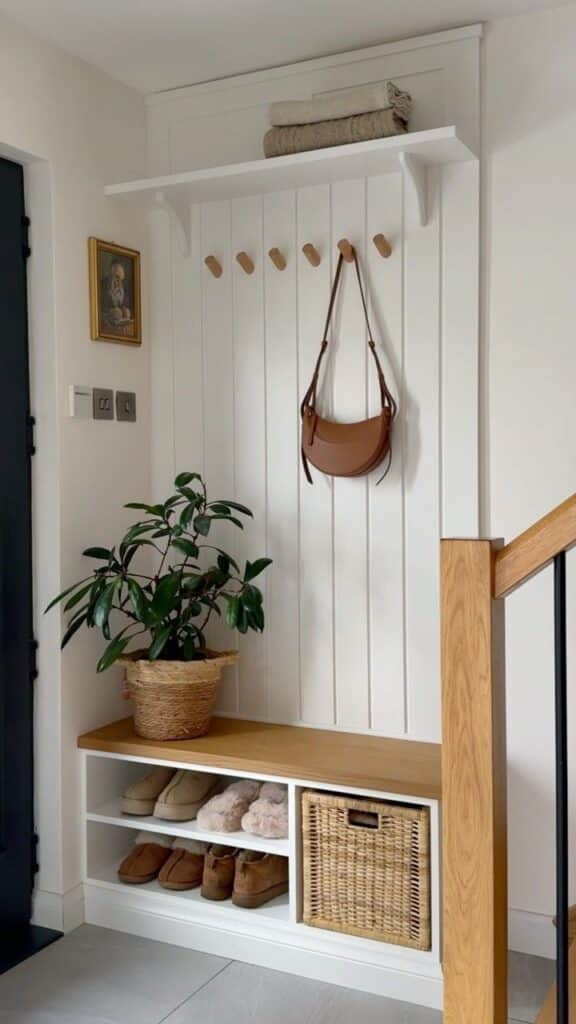
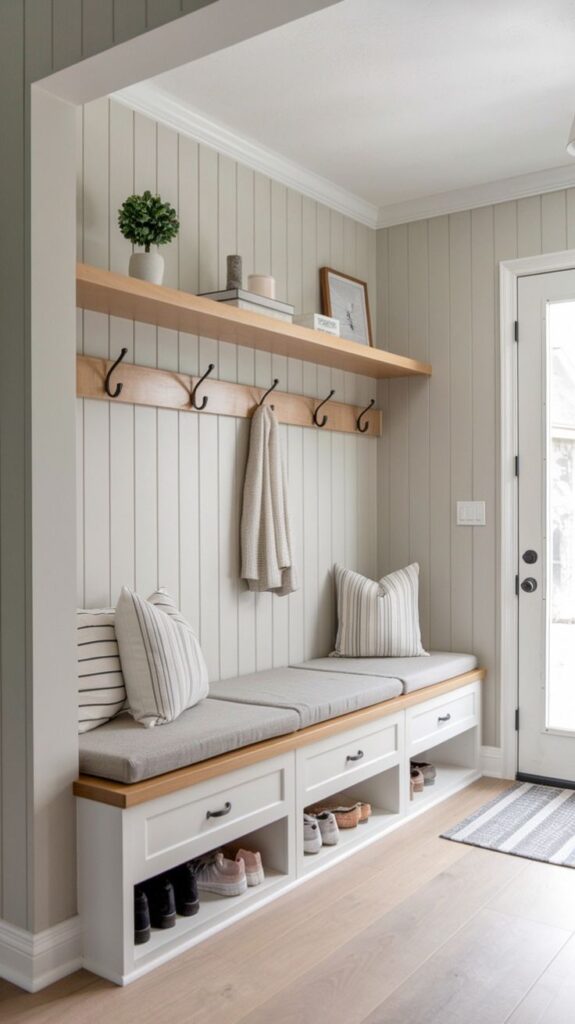
Essential Entryway Furniture and Storage Solutions
The right entryway furniture combines functionality with style, creating an organized space that sets the tone for your home. Effective storage solutions help manage daily clutter while making the most of available space.
Choosing a Console Table
Console tables serve as versatile anchors for any entryway. Select one with drawers or shelves to maximize storage potential while maintaining a sleek profile against the wall.
Solid wood options offer durability and timeless appeal, though modern designs featuring metal and glass can create a more contemporary look. Consider your space constraints—narrow hallways benefit from tables less than 12 inches deep.
Look for console tables with specific storage features like mail slots, key hooks, or hidden compartments. These thoughtful additions help organize everyday essentials that tend to accumulate near doorways.
The height should complement other elements in your entryway. Standard console tables measure 30-36 inches tall, aligning perfectly with most wall switches and doorknobs.
Selecting a Storage Bench and Shoe Rack
A storage bench combines seating with concealed storage, perfect for entryways where space is at a premium. Look for benches with hinged tops or pull-out drawers that can hide seasonal accessories or rarely used items.
Consider the weight capacity when selecting a bench, especially if multiple family members will use it simultaneously. Quality benches should support at least 250-300 pounds without compromising structural integrity.
Shoe racks prevent footwear clutter while keeping your most-worn pairs accessible. Tiered options maximize vertical space, while cabinet-style shoe storage conceals visual clutter behind doors.
For families, calculate storage needs based on 3-4 pairs of shoes per person for everyday use. Many retailers offer free shipping on these essential pieces, making it easier to find the perfect fit for your entryway.
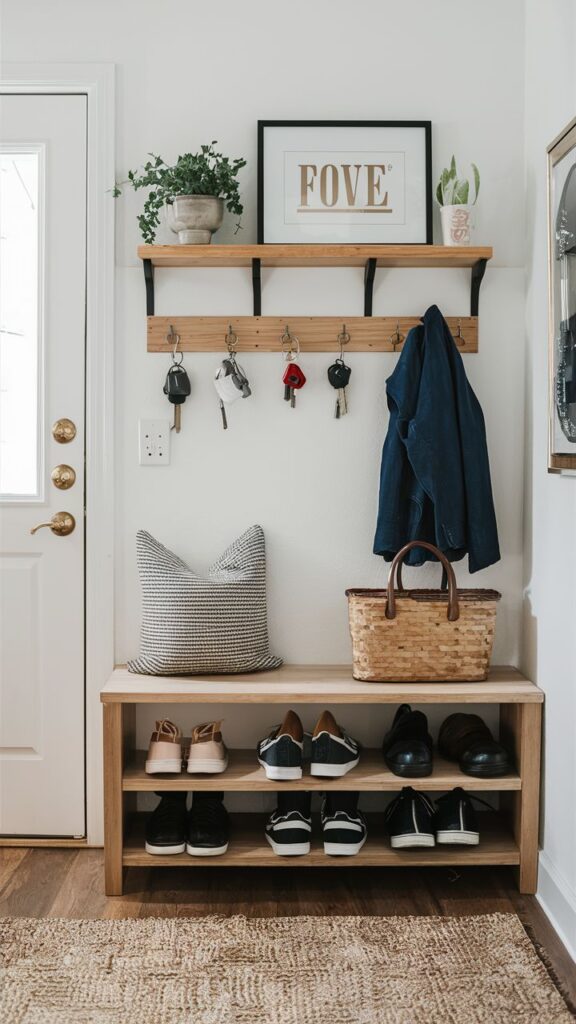
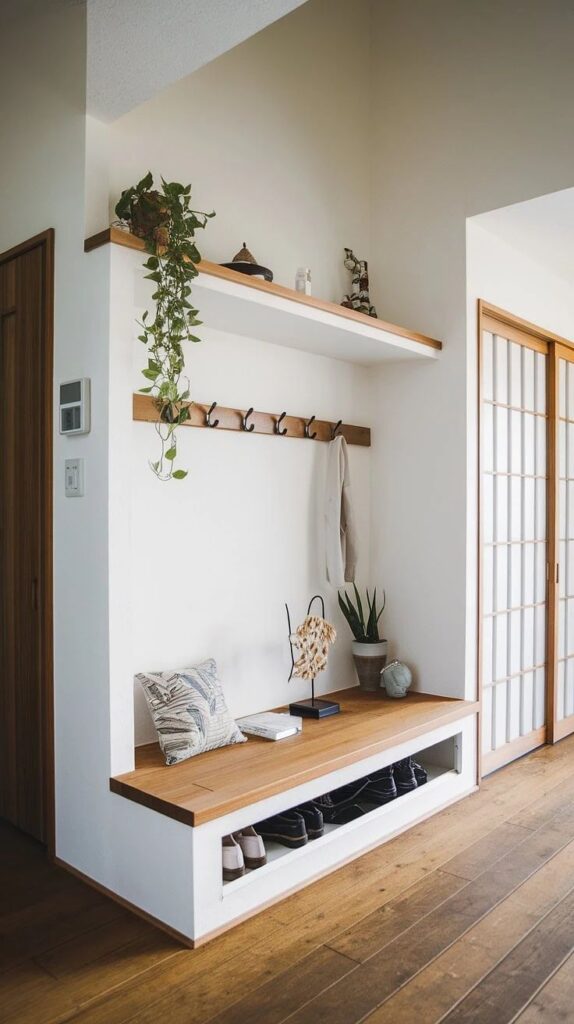
Adding Seating Options
Incorporating seating in your entryway creates a practical spot for putting on shoes or setting down bags. Beyond storage benches, consider accent chairs or stools that can be tucked under console tables when not in use.
Choose seating that complements your entryway’s dimensions—slim silhouettes work best in narrow spaces. Upholstered options add comfort and texture, while materials like leather or performance fabrics offer durability against high traffic.
For homes with limited square footage, look for nesting stools or folding chairs that can be deployed when needed and stored easily. These versatile pieces provide seating without permanently claiming valuable floor space.
The height of your seating should allow for comfortable use—typically 17-19 inches from the floor, matching standard bench heights.
Coat Racks and Wall Hooks
Wall-mounted hooks maximize vertical space while keeping coats, bags, and accessories organized and accessible. Install them at varying heights to accommodate both adults and children in busy households.
Freestanding coat racks work well in entryways with higher ceilings or where drilling into walls isn’t possible. Look for models with built-in umbrella stands or small shelves for added functionality.
Consider the weight capacity of your hanging solution—quality hooks should support 10-15 pounds each without pulling from the wall. Decorative hooks can also serve as design elements, adding personality to your entryway.
For comprehensive organization, combine several types of hooks: heavy-duty options for winter coats, medium hooks for everyday jackets, and smaller versions for keys and accessories.
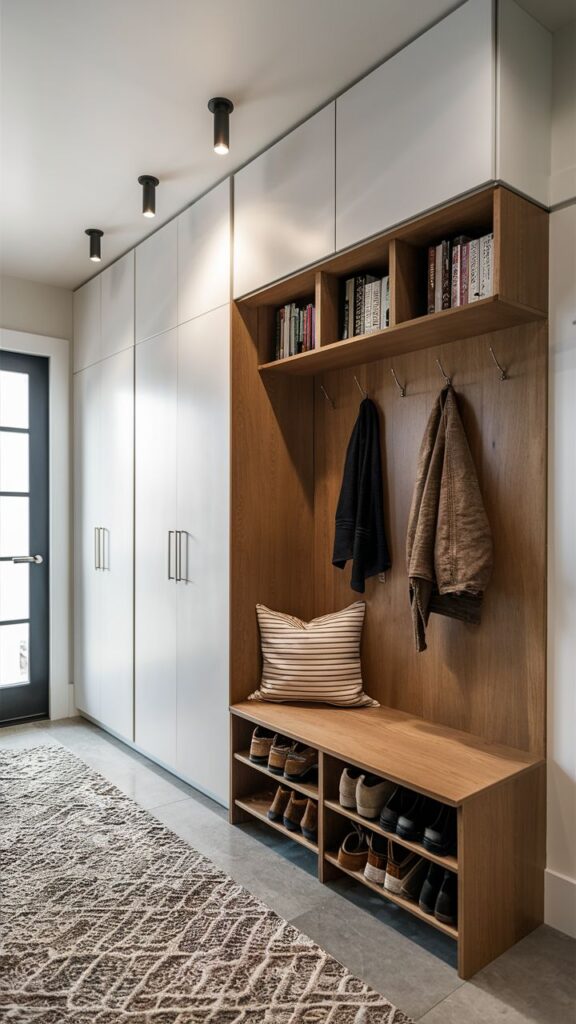
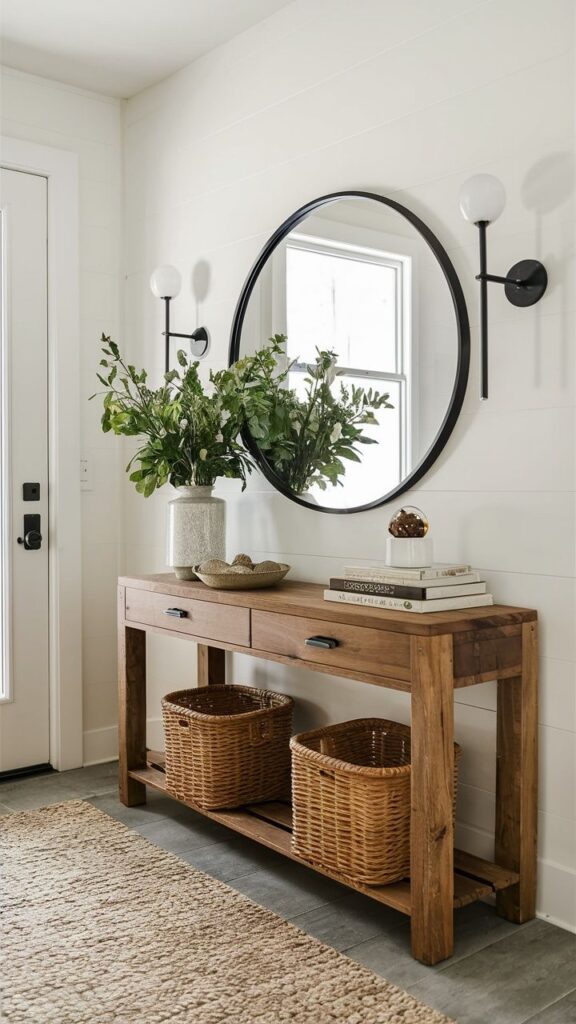
Walls, Ceilings, and Floor Treatments
The entryway creates the first impression of your home, making wall, ceiling, and floor treatments crucial design elements. Thoughtful combinations of materials, textures, and colors can transform this space into a welcoming introduction to your personal style.
Paint Colors and Wallpaper for Entryways
Selecting the right paint color for your entryway sets the tone for your entire home. Light neutrals like greige, soft white, and pale blue make smaller entryways feel more spacious and airy. For a bolder statement, consider deep navy, emerald green, or charcoal gray on an accent wall.
Wallpaper offers distinctive pattern and texture options that paint alone cannot achieve. Modern geometric patterns create visual interest, while botanical prints bring natural elements indoors. Textured wallpapers, including grasscloth and linen-look options, add depth without overwhelming the space.
For two-story entryways, extend your wall treatment upward to visually connect both levels. This creates a cohesive look and emphasizes the impressive height of your space.
Wall Paneling, Trim, and Sanding
Wall paneling adds architectural interest and durability to entryway walls. Shiplap creates a casual, farmhouse feel, while board and batten offers a more traditional, structured appearance. Wainscoting provides both protection and visual appeal when installed on the lower portion of walls.
When installing trim, ensure proportions complement your ceiling height. Taller baseboards (5-7 inches) create a more substantial look, while crown molding draws the eye upward and adds elegance.
Proper surface preparation is essential for a professional finish. Sand walls thoroughly before applying paint or wallpaper to remove imperfections. For existing trim, sand with progressively finer grits (starting at 100-120 and finishing with 180-220) for the smoothest results.
Tip: Paint trim in semi-gloss or high-gloss finish for durability and easy cleaning in this high-traffic area.
Rugs and Carpets for Entryway Floors
A well-chosen rug or carpet anchors your entryway and protects flooring from outdoor elements. Select durable, stain-resistant materials like wool, polypropylene, or nylon blends that withstand heavy foot traffic.
For high-traffic entryways, darker patterns and colors hide dirt and wear better than light solids. Consider these practical options:
- Indoor/outdoor rugs: Easy to clean and highly durable
- Vintage-inspired patterns: Camouflage stains and add character
- Natural fiber rugs: Sisal and jute offer texture and resilience
Size your rug appropriately—it should extend at least 6 inches beyond your door swing and allow for comfortable movement through the space. For larger entryways, ensure the rug is proportional to the room.
Ceiling Design Ideas
Your entryway ceiling presents unique design opportunities, especially in spaces with generous height. Painted ceilings in subtle contrasting colors (slightly lighter or darker than walls) add dimension without overwhelming the space.
Wood treatments create warmth and visual interest. Consider these options:
| Ceiling Treatment | Best For | Effect |
|---|---|---|
| Coffered ceiling | Traditional homes | Adds architectural detail and formality |
| Wood planking | Farmhouse/coastal styles | Creates warmth and casual elegance |
| Beadboard | Cottage/transitional styles | Provides texture and charm |
In two-story entryways, statement lighting fixtures become focal points that draw the eye upward. Choose a chandelier or pendant that complements your ceiling height—larger fixtures work well in taller spaces.
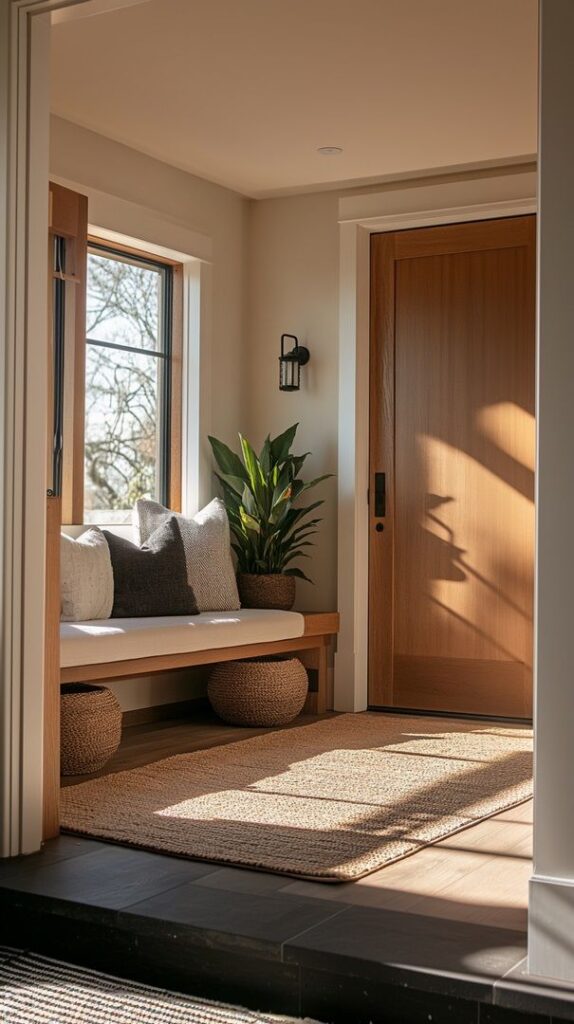
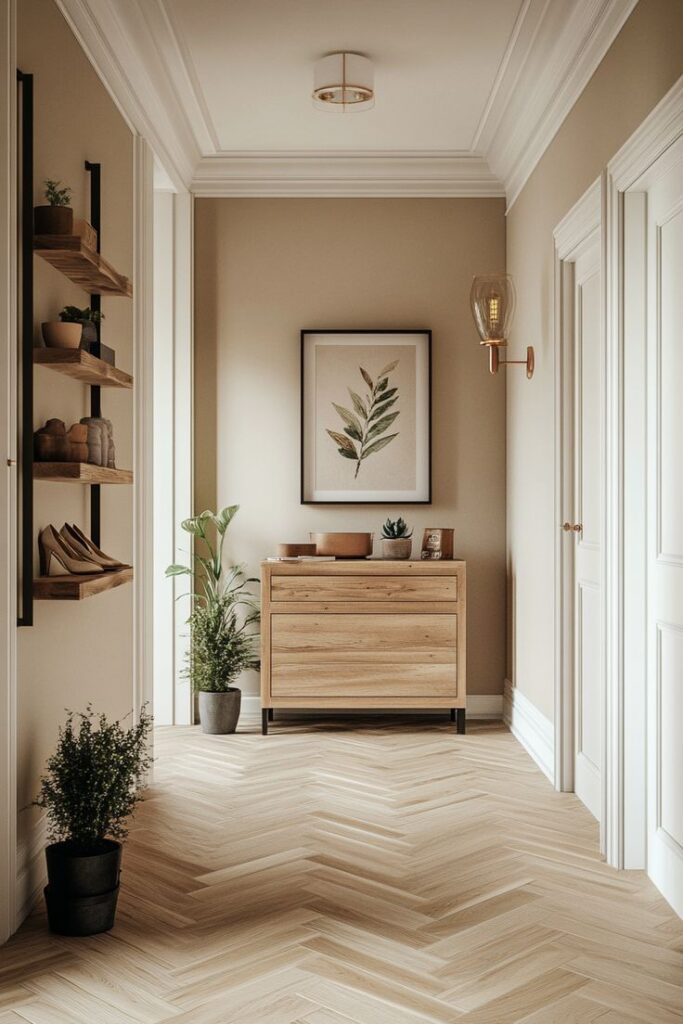
Lighting and Reflective Accents
Proper lighting and reflective elements create visual impact in your entryway while making the space appear larger and more welcoming. Strategic placement of lamps, mirrors, and decorative accents can transform even the smallest foyer into an impressive introduction to your home.
Choosing the Right Entryway Lamp
The right lamp serves both functional and aesthetic purposes in your entryway. For overhead lighting, consider a statement chandelier or pendant that complements your home’s architectural style. These fixtures provide general illumination while making a strong first impression.
Table lamps work well on console tables or sideboards, offering a warm glow at eye level. Choose a lamp that’s proportionate to your space—taller, slimmer lamps for narrow entryways and more substantial pieces for larger foyers.
Wall sconces save valuable floor space while providing ambient lighting. Install them in pairs for symmetrical balance or use them to highlight artwork or architectural features.
For larger entryways, layered lighting works best. Combine overhead fixtures with accent lighting to eliminate shadows and create visual interest throughout the space.
Using Mirrors to Enhance Space
Mirrors are essential entryway elements that serve multiple functions. They provide a last-minute check before leaving home while visually doubling your space and reflecting available light.
Position mirrors across from windows or light sources to maximize brightness. A large mirror centered on the main wall creates a focal point and sense of expanded space. For narrower entryways, tall vertical mirrors elongate the area.
Consider decorative framed options that complement your interior style. Ornate gold frames add elegance, while sleek frameless mirrors create contemporary appeal.
Mirrored furniture pieces like console tables or cabinets achieve the reflective benefit while providing functional storage. These pieces work especially well in smaller entryways where wall space is limited.
Decorative Accents and Accessories
Thoughtfully chosen decorative elements add personality to your entryway lighting scheme. Crystal or glass accessories catch and scatter light beautifully. Consider transparent vases, decorative bowls, or crystal sculptures that interact with your lighting.
Metallic accents like brass candlesticks, silver photo frames, or copper decorative objects reflect light and add warmth. Mix metals for an eclectic look or maintain consistency for a more cohesive aesthetic.
Light-colored artwork with glossy finishes helps bounce light around the space. Choose pieces with reflective elements like metallics or high-gloss finishes.
Arrange your decorative accents in varying heights to create visual interest. Use books or small boxes as risers to elevate certain pieces. This creates a more dynamic composition while allowing light to interact with different surfaces and textures.
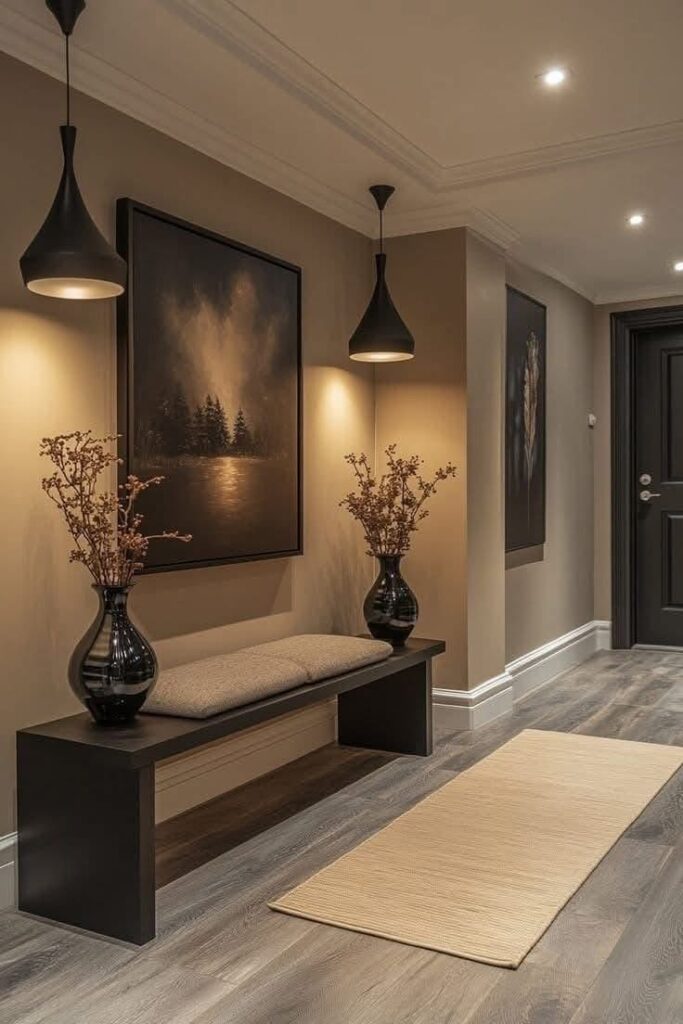
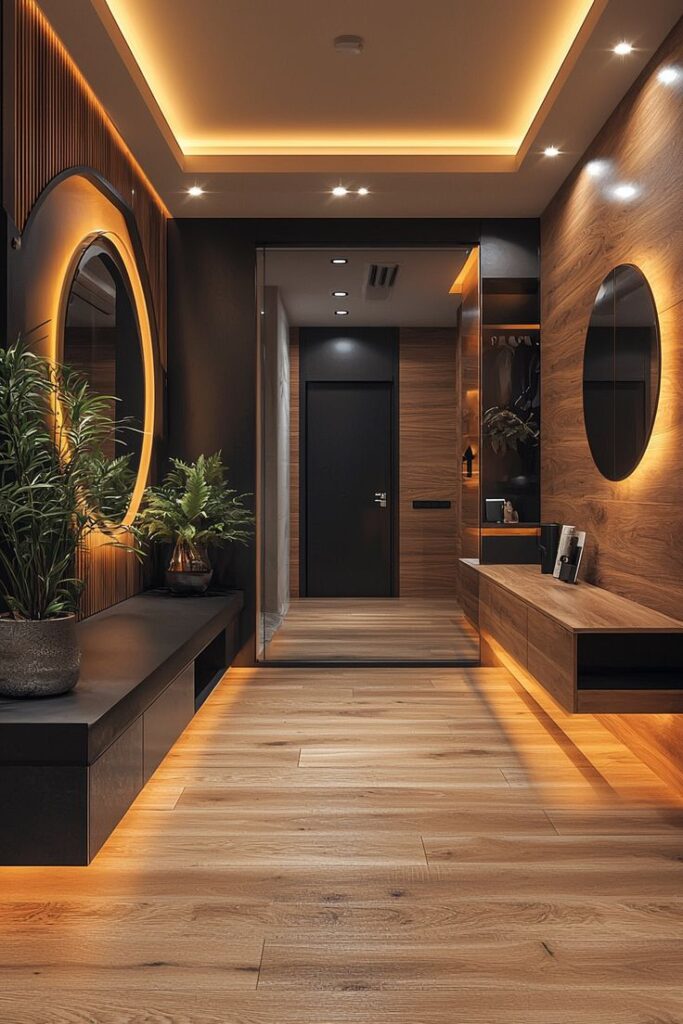
Practical Entryway Maintenance and Organization
Maintaining a functional entryway requires consistent care and thoughtful organization to handle the daily traffic flow. A well-maintained entrance sets the tone for your entire home while supporting smooth transitions as you come and go.
Dust Control and Cleanliness
Dust accumulates quickly in entryways due to constant foot traffic bringing outdoor particles inside. Place a quality doormat both outside and inside your entrance to trap dirt before it spreads throughout your home.
Implement a quick daily wipe-down routine for high-touch surfaces like doorknobs, light switches, and console tables. This five-minute habit prevents buildup and keeps surfaces looking fresh.
Consider installing a shoe removal station with a bench and designated storage to minimize dirt tracking. This simple boundary creates a cleaner transition from outdoors to indoors.
For hard flooring, keep a microfiber mop nearby for quick spot cleaning. Vacuum fabric elements like rugs and upholstered benches weekly to prevent dust from becoming embedded in fibers.
Organizational Tips for Daily Ease
Create designated zones for each family member with personal hooks, bins, or cubbies. This approach eliminates confusion and clutter when everyone knows exactly where their items belong.
Install versatile storage solutions that adapt to your specific needs:
- Wall-mounted hooks for coats, bags, and dog leashes
- Closed cabinets to conceal visual clutter
- Open shelving with labeled baskets for seasonal items
- Drawer dividers for small essentials like keys and sunglasses
Implement the “one in, one out” rule to prevent accumulation. When you bring home a new jacket or bag, consider removing one you no longer use.
Keep daily essentials visible and accessible while storing rarely-used items in less prime locations. Your storage system should prioritize frequency of use.
Seasonal Updates and Transitions
Rotate your entryway storage contents quarterly to accommodate changing weather needs. During spring cleaning, swap heavy winter gear for lightweight jackets and rain accessories.
Create a compact “transition bin” for items in between seasons. This temporary storage solution helps manage the awkward periods when weather fluctuates unpredictably.
Assess your entryway’s functionality each season and make adjustments as needed. Perhaps summer requires additional storage for beach bags, while winter demands more hook space for bulky coats.
Seasonal Maintenance Checklist:
- Clean light fixtures and replace bulbs
- Wash or dry clean fabric elements
- Touch up paint on high-traffic walls
- Refresh weatherstripping around doors
- Reorganize storage based on current needs
Schedule deep cleaning sessions quarterly to address overlooked areas like baseboards, ceiling corners, and inside storage compartments where dust settles.
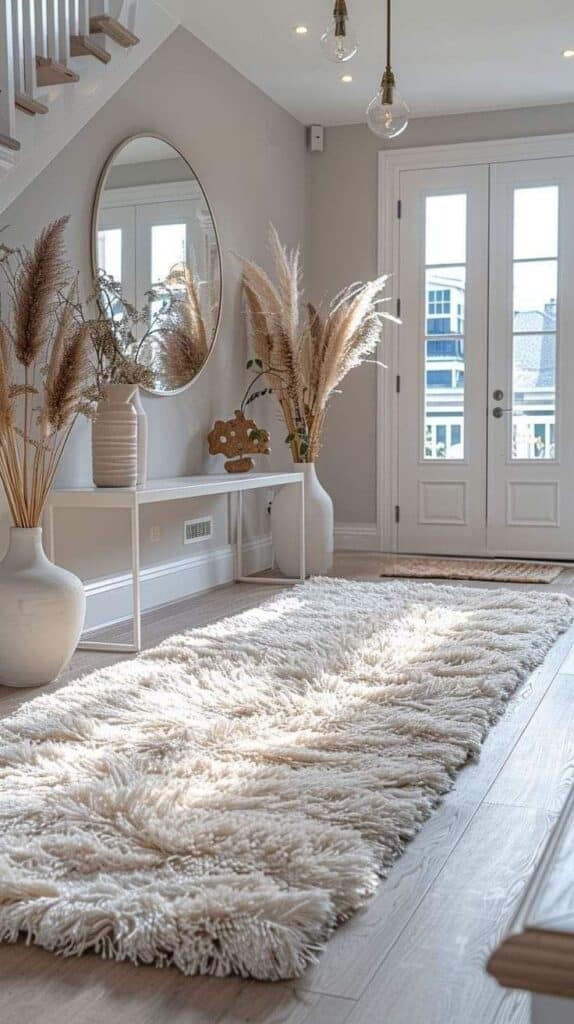
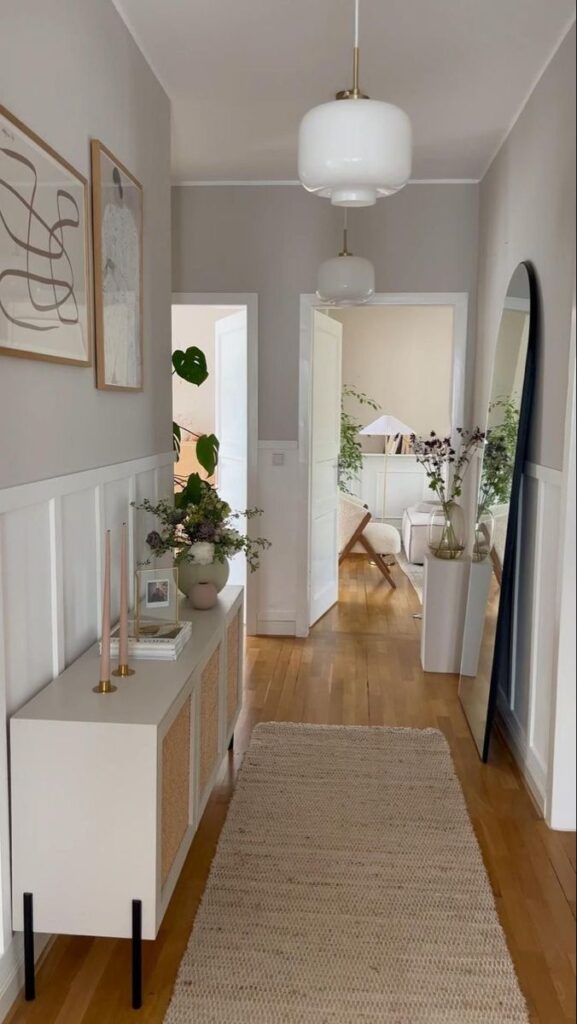
Connecting the Entryway to Adjacent Spaces
Creating a cohesive flow between your entryway and other areas of your home establishes visual harmony and improves functionality. A well-designed transition enhances the overall aesthetic while maintaining distinct purposes for each space.
Transitioning to the Dining Room and Beyond
The connection between your entryway and dining room requires thoughtful planning to maintain design continuity. Consider using consistent flooring materials to create a natural flow between these spaces. This approach visually expands smaller areas while providing a unified look.
Color coordination plays a crucial role in this transition. You can use complementary paint colors or incorporate accent pieces that reference both spaces. For example, artwork in your entryway might feature colors that appear in your dining room furnishings.
Lighting fixtures that share design elements or finishes can effectively bridge these areas. Consider pendant lights in your entryway that complement your dining room chandelier without being identical.
Strategic furniture placement can define boundaries without creating harsh divisions. As mentioned in search results, you might position a sofa or sectional to create a subtle divide between the front door and living spaces.
Multipurpose Entryway Furniture like Buffets
Buffets traditionally associated with dining rooms make excellent crossover pieces for entryways. These versatile furnishings provide storage while establishing a stylistic connection to adjacent dining spaces.
A buffet positioned in your entryway offers practical storage for items like keys, mail, and seasonal accessories. Choose one with drawers for smaller items and cabinet space for larger belongings. This helps maintain a clutter-free environment in your home’s entrance.
When selecting a buffet, consider how its design elements will complement both your entryway and dining room. Look for finishes and hardware that coordinate with nearby spaces to create visual continuity.
For smaller entryways, consider a narrow console-style buffet that provides functionality without overwhelming the space. Top it with a mirror to amplify light and create the illusion of a larger area—a technique mentioned in the search results for hallway design.
- 0shares
- Facebook0
- Pinterest0
- Twitter0

